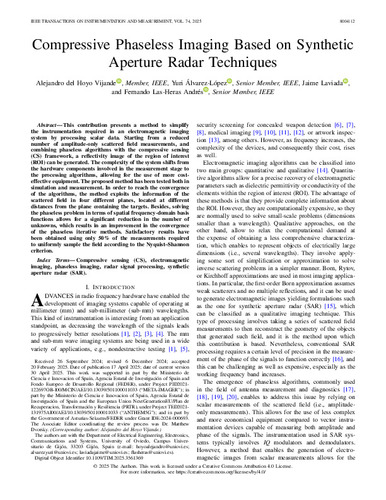Compressive Phaseless Imaging Based on Synthetic Aperture Radar Techniques
Autor(es) y otros:
Palabra(s) clave:
Compressive Sensing (CS)
Electromagnetic Imaging
Phaseless Imaging
Radar Signal Processing
Synthetic Aperture Radar (SAR)
Fecha de publicación:
Editorial:
Institute of Electrical and Electronics Engineers Inc. (IEEE)
Versión del editor:
Citación:
Resumen:
This contribution presents a method to simplify the instrumentation required in an electromagnetic imaging system by processing scalar data. Starting from a reduced number of amplitude-only scattered field measurements, and combining phaseless algorithms with the compressive sensing framework, a reflectivity image of the region of interest can be generated. The complexity of the system shifts from the hardware components involved in the measurement stage to the processing algorithms, allowing for the use of more cost-effective equipment. The proposed method has been tested both in simulation and measurement. In order to reach the convergence of the algorithms, the method exploits the information of the scattered field in four different planes, located at different distances from the plane containing the targets. Besides, solving the phaseless problem in terms of spatial frequency domain basis functions allows for a significant reduction in the number of unknowns, which results in an improvement in the convergence of the phaseless iterative methods. Satisfactory results have been obtained using only 50% of the measurements required to uniformly sample the field according to Nyquist-Shannon criterion.
This contribution presents a method to simplify the instrumentation required in an electromagnetic imaging system by processing scalar data. Starting from a reduced number of amplitude-only scattered field measurements, and combining phaseless algorithms with the compressive sensing framework, a reflectivity image of the region of interest can be generated. The complexity of the system shifts from the hardware components involved in the measurement stage to the processing algorithms, allowing for the use of more cost-effective equipment. The proposed method has been tested both in simulation and measurement. In order to reach the convergence of the algorithms, the method exploits the information of the scattered field in four different planes, located at different distances from the plane containing the targets. Besides, solving the phaseless problem in terms of spatial frequency domain basis functions allows for a significant reduction in the number of unknowns, which results in an improvement in the convergence of the phaseless iterative methods. Satisfactory results have been obtained using only 50% of the measurements required to uniformly sample the field according to Nyquist-Shannon criterion.
Patrocinado por:
This work was supported in part by the Ministerio de Ciencia e Innovacion of Spain, Agencia Estatal de Investigación of Spain and Fondo Europeo de Desarrollo Regional (FEDER), under Project PID2021-122697OB-I00/MCIN/AEI/10.13039/501100011033 (“META-IMAGER”); in part by the Ministerio de Ciencia e Innovacion of Spain, Agencia Estatal de Investigación of Spain and the European Union NextGenerationEU/Plan de Recuperacion, Transformación y Resiliencia (PRTR), under Project TED2021-131975AI00/AEI/10.13039/501100011033 (“ANTHEM5G”); and in part by the Government of Asturias-Sekuens/FEDER under Grant IDE-2024-000693.
Colecciones
Ficheros en el ítem





